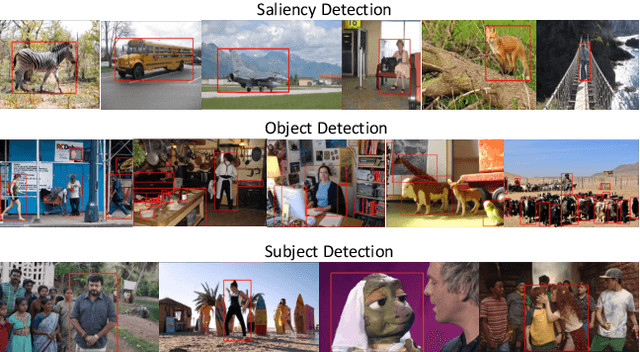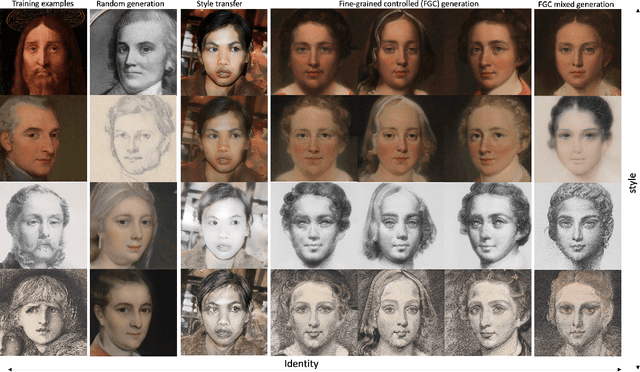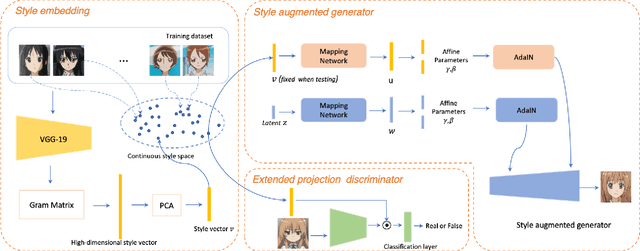Xin Miao
Accelerated Patient-specific Non-Cartesian MRI Reconstruction using Implicit Neural Representations
Mar 07, 2025Abstract:The scanning time for a fully sampled MRI can be undesirably lengthy. Compressed sensing has been developed to minimize image artifacts in accelerated scans, but the required iterative reconstruction is computationally complex and difficult to generalize on new cases. Image-domain-based deep learning methods (e.g., convolutional neural networks) emerged as a faster alternative but face challenges in modeling continuous k-space, a problem amplified with non-Cartesian sampling commonly used in accelerated acquisition. In comparison, implicit neural representations can model continuous signals in the frequency domain and thus are compatible with arbitrary k-space sampling patterns. The current study develops a novel generative-adversarially trained implicit neural representations (k-GINR) for de novo undersampled non-Cartesian k-space reconstruction. k-GINR consists of two stages: 1) supervised training on an existing patient cohort; 2) self-supervised patient-specific optimization. In stage 1, the network is trained with the generative-adversarial network on diverse patients of the same anatomical region supervised by fully sampled acquisition. In stage 2, undersampled k-space data of individual patients is used to tailor the prior-embedded network for patient-specific optimization. The UCSF StarVIBE T1-weighted liver dataset was evaluated on the proposed framework. k-GINR is compared with an image-domain deep learning method, Deep Cascade CNN, and a compressed sensing method. k-GINR consistently outperformed the baselines with a larger performance advantage observed at very high accelerations (e.g., 20 times). k-GINR offers great value for direct non-Cartesian k-space reconstruction for new incoming patients across a wide range of accelerations liver anatomy.
Reasoning based on symbolic and parametric knowledge bases: a survey
Jan 02, 2025Abstract:Reasoning is fundamental to human intelligence, and critical for problem-solving, decision-making, and critical thinking. Reasoning refers to drawing new conclusions based on existing knowledge, which can support various applications like clinical diagnosis, basic education, and financial analysis. Though a good number of surveys have been proposed for reviewing reasoning-related methods, none of them has systematically investigated these methods from the viewpoint of their dependent knowledge base. Both the scenarios to which the knowledge bases are applied and their storage formats are significantly different. Hence, investigating reasoning methods from the knowledge base perspective helps us better understand the challenges and future directions. To fill this gap, this paper first classifies the knowledge base into symbolic and parametric ones. The former explicitly stores information in human-readable symbols, and the latter implicitly encodes knowledge within parameters. Then, we provide a comprehensive overview of reasoning methods using symbolic knowledge bases, parametric knowledge bases, and both of them. Finally, we identify the future direction toward enhancing reasoning capabilities to bridge the gap between human and machine intelligence.
Toxicity Detection towards Adaptability to Changing Perturbations
Dec 17, 2024Abstract:Toxicity detection is crucial for maintaining the peace of the society. While existing methods perform well on normal toxic contents or those generated by specific perturbation methods, they are vulnerable to evolving perturbation patterns. However, in real-world scenarios, malicious users tend to create new perturbation patterns for fooling the detectors. For example, some users may circumvent the detector of large language models (LLMs) by adding `I am a scientist' at the beginning of the prompt. In this paper, we introduce a novel problem, i.e., continual learning jailbreak perturbation patterns, into the toxicity detection field. To tackle this problem, we first construct a new dataset generated by 9 types of perturbation patterns, 7 of them are summarized from prior work and 2 of them are developed by us. We then systematically validate the vulnerability of current methods on this new perturbation pattern-aware dataset via both the zero-shot and fine tuned cross-pattern detection. Upon this, we present the domain incremental learning paradigm and the corresponding benchmark to ensure the detector's robustness to dynamically emerging types of perturbed toxic text. Our code and dataset are provided in the appendix and will be publicly available at GitHub, by which we wish to offer new research opportunities for the security-relevant communities.
Rapid Reconstruction of Extremely Accelerated Liver 4D MRI via Chained Iterative Refinement
Dec 14, 2024



Abstract:Abstract Purpose: High-quality 4D MRI requires an impractically long scanning time for dense k-space signal acquisition covering all respiratory phases. Accelerated sparse sampling followed by reconstruction enhancement is desired but often results in degraded image quality and long reconstruction time. We hereby propose the chained iterative reconstruction network (CIRNet) for efficient sparse-sampling reconstruction while maintaining clinically deployable quality. Methods: CIRNet adopts the denoising diffusion probabilistic framework to condition the image reconstruction through a stochastic iterative denoising process. During training, a forward Markovian diffusion process is designed to gradually add Gaussian noise to the densely sampled ground truth (GT), while CIRNet is optimized to iteratively reverse the Markovian process from the forward outputs. At the inference stage, CIRNet performs the reverse process solely to recover signals from noise, conditioned upon the undersampled input. CIRNet processed the 4D data (3D+t) as temporal slices (2D+t). The proposed framework is evaluated on a data cohort consisting of 48 patients (12332 temporal slices) who underwent free-breathing liver 4D MRI. 3-, 6-, 10-, 20- and 30-times acceleration were examined with a retrospective random undersampling scheme. Compressed sensing (CS) reconstruction with a spatiotemporal constraint and a recently proposed deep network, Re-Con-GAN, are selected as baselines. Results: CIRNet consistently achieved superior performance compared to CS and Re-Con-GAN. The inference time of CIRNet, CS, and Re-Con-GAN are 11s, 120s, and 0.15s. Conclusion: A novel framework, CIRNet, is presented. CIRNet maintains useable image quality for acceleration up to 30 times, significantly reducing the burden of 4DMRI.
Enhancing Relation Extraction via Supervised Rationale Verification and Feedback
Dec 10, 2024Abstract:Despite the rapid progress that existing automated feedback methods have made in correcting the output of large language models (LLMs), these methods cannot be well applied to the relation extraction (RE) task due to their designated feedback objectives and correction manner. To address this problem, we propose a novel automated feedback framework for RE, which presents a rationale supervisor to verify the rationale and provide re-selected demonstrations as feedback to correct the initial prediction. Specifically, we first design a causal intervention and observation method for to collect biased/unbiased rationales for contrastive training the rationale supervisor. Then, we present a verification-feedback-correction procedure to iteratively enhance LLMs' capability of handling the RE task. Extensive experiments prove that our proposed framework significantly outperforms existing methods.
Paired Conditional Generative Adversarial Network for Highly Accelerated Liver 4D MRI
May 20, 2024Abstract:Purpose: 4D MRI with high spatiotemporal resolution is desired for image-guided liver radiotherapy. Acquiring densely sampling k-space data is time-consuming. Accelerated acquisition with sparse samples is desirable but often causes degraded image quality or long reconstruction time. We propose the Reconstruct Paired Conditional Generative Adversarial Network (Re-Con-GAN) to shorten the 4D MRI reconstruction time while maintaining the reconstruction quality. Methods: Patients who underwent free-breathing liver 4D MRI were included in the study. Fully- and retrospectively under-sampled data at 3, 6 and 10 times (3x, 6x and 10x) were first reconstructed using the nuFFT algorithm. Re-Con-GAN then trained input and output in pairs. Three types of networks, ResNet9, UNet and reconstruction swin transformer, were explored as generators. PatchGAN was selected as the discriminator. Re-Con-GAN processed the data (3D+t) as temporal slices (2D+t). A total of 48 patients with 12332 temporal slices were split into training (37 patients with 10721 slices) and test (11 patients with 1611 slices). Results: Re-Con-GAN consistently achieved comparable/better PSNR, SSIM, and RMSE scores compared to CS/UNet models. The inference time of Re-Con-GAN, UNet and CS are 0.15s, 0.16s, and 120s. The GTV detection task showed that Re-Con-GAN and CS, compared to UNet, better improved the dice score (3x Re-Con-GAN 80.98%; 3x CS 80.74%; 3x UNet 79.88%) of unprocessed under-sampled images (3x 69.61%). Conclusion: A generative network with adversarial training is proposed with promising and efficient reconstruction results demonstrated on an in-house dataset. The rapid and qualitative reconstruction of 4D liver MR has the potential to facilitate online adaptive MR-guided radiotherapy for liver cancer.
Large Language Models as Counterfactual Generator: Strengths and Weaknesses
May 24, 2023Abstract:Large language models (LLMs) have demonstrated remarkable performance in a range of natural language understanding and generation tasks. Yet, their ability to generate counterfactuals, which can be used for areas like data augmentation, remains under-explored. This study aims to investigate the counterfactual generation capabilities of LLMs and analysis factors that influence this ability. First, we evaluate how effective are LLMs in counterfactual generation through data augmentation experiments for small language models (SLMs) across four tasks: sentiment analysis, natural language inference, named entity recognition, and relation extraction. While LLMs show promising enhancements in various settings, they struggle in complex tasks due to their self-limitations and the lack of logical guidance to produce counterfactuals that align with commonsense. Second, our analysis reveals the pivotal role of providing accurate task definitions and detailed step-by-step instructions to LLMs in generating counterfactuals. Interestingly, we also find that LLMs can generate reasonable counterfactuals even with unreasonable demonstrations, which illustrates that demonstrations are primarily to regulate the output format.This study provides the first comprehensive insight into counterfactual generation abilities of LLMs, and offers a novel perspective on utilizing LLMs for data augmentation to enhance SLMs.
Effectively leveraging Multi-modal Features for Movie Genre Classification
Mar 24, 2022



Abstract:Movie genre classification has been widely studied in recent years due to its various applications in video editing, summarization, and recommendation. Prior work has typically addressed this task by predicting genres based solely on the visual content. As a result, predictions from these methods often perform poorly for genres such as documentary or musical, since non-visual modalities like audio or language play an important role in correctly classifying these genres. In addition, the analysis of long videos at frame level is always associated with high computational cost and makes the prediction less efficient. To address these two issues, we propose a Multi-Modal approach leveraging shot information, MMShot, to classify video genres in an efficient and effective way. We evaluate our method on MovieNet and Condensed Movies for genre classification, achieving 17% ~ 21% improvement on mean Average Precision (mAP) over the state-of-the-art. Extensive experiments are conducted to demonstrate the ability of MMShot for long video analysis and uncover the correlations between genres and multiple movie elements. We also demonstrate our approach's ability to generalize by evaluating the scene boundary detection task, achieving 1.1% improvement on Average Precision (AP) over the state-of-the-art.
ImageSubject: A Large-scale Dataset for Subject Detection
Jan 09, 2022



Abstract:Main subjects usually exist in the images or videos, as they are the objects that the photographer wants to highlight. Human viewers can easily identify them but algorithms often confuse them with other objects. Detecting the main subjects is an important technique to help machines understand the content of images and videos. We present a new dataset with the goal of training models to understand the layout of the objects and the context of the image then to find the main subjects among them. This is achieved in three aspects. By gathering images from movie shots created by directors with professional shooting skills, we collect the dataset with strong diversity, specifically, it contains 107\,700 images from 21\,540 movie shots. We labeled them with the bounding box labels for two classes: subject and non-subject foreground object. We present a detailed analysis of the dataset and compare the task with saliency detection and object detection. ImageSubject is the first dataset that tries to localize the subject in an image that the photographer wants to highlight. Moreover, we find the transformer-based detection model offers the best result among other popular model architectures. Finally, we discuss the potential applications and conclude with the importance of the dataset.
Fine-Grained Control of Artistic Styles in Image Generation
Oct 25, 2021



Abstract:Recent advances in generative models and adversarial training have enabled artificially generating artworks in various artistic styles. It is highly desirable to gain more control over the generated style in practice. However, artistic styles are unlike object categories -- there are a continuous spectrum of styles distinguished by subtle differences. Few works have been explored to capture the continuous spectrum of styles and apply it to a style generation task. In this paper, we propose to achieve this by embedding original artwork examples into a continuous style space. The style vectors are fed to the generator and discriminator to achieve fine-grained control. Our method can be used with common generative adversarial networks (such as StyleGAN). Experiments show that our method not only precisely controls the fine-grained artistic style but also improves image quality over vanilla StyleGAN as measured by FID.
 Add to Chrome
Add to Chrome Add to Firefox
Add to Firefox Add to Edge
Add to Edge